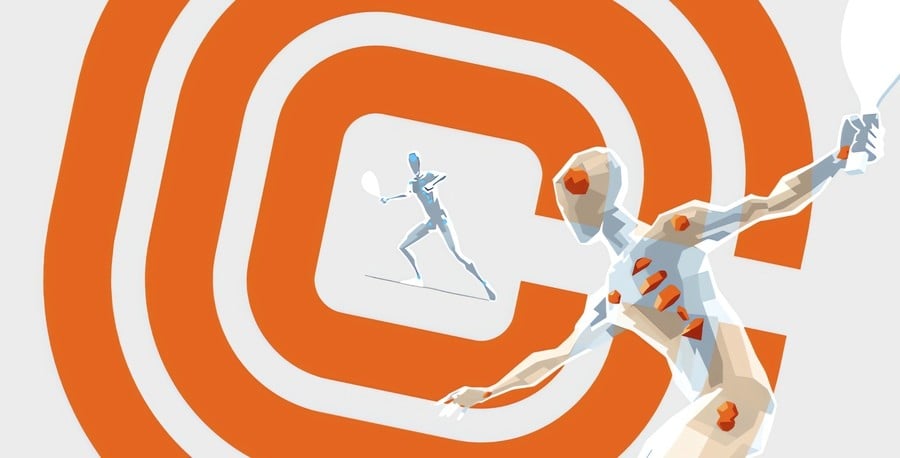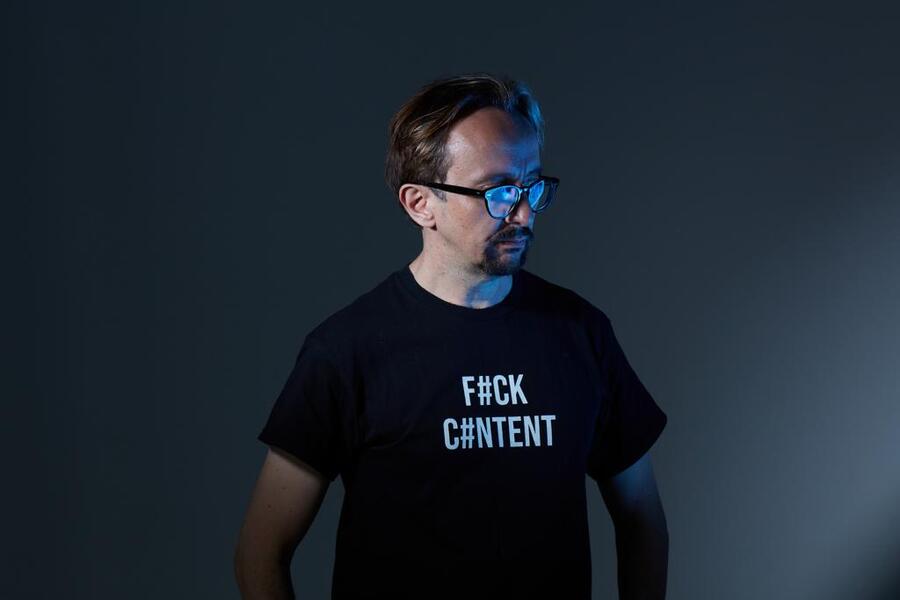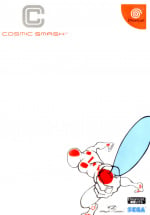
The arrival of C-Smash VRS on PSVR2 is significant because it marks the revival of one of Sega's more obscure classics. Released in arcades in January 2001 – the same month that Sega announced it was exiting the home console arena to become a third-party publisher – Cosmic Smash was an instantly compelling experience, a fusion of the real-world sport of squash and Breakout which took place in a Tron-style setting not entirely dissimilar to that of its Sega stablemate Rez, which also arrived in Japan the same year.
It was just this beautiful, iconic, gem; even the box was stunning, with the orange disc shining through that sort of milky white sort of cover
"I was at NYU and loved Dreamcast," explains Jörg Tittel, the key figure behind 2023's unlikely resurrection of Cosmic Smash. "I did an interview with Yoshitaka Amano for Famitsu DC, the Dreamcast version of the magazine. When I got the issue in the post, I flipped the page and saw this screenshot which just blew my mind – it was Cosmic Smash. I didn't know at the time, of course, that the Dreamcast would be discontinued a couple of months later, but when it eventually came out in September 2001, it was just this beautiful, iconic, gem; even the box was stunning, with the orange disc shining through that sort of milky white sort of cover. The thought that went into it is amazing."
Cosmic Smash was created by Sega Rosso, one of several internal development teams that operated within Sega at the turn of the millennium. "United Game Artists, Sega Rosso, Amusement Vision… all those teams were owned by Sega, but they were fully independent in terms of their operations," explains Tittel. "When developers founded the studios, there was no brief; they said 'make the game you want to make', which is the spirit of indies. That's why we have things like Jet Set Radio, and that's why we have Chu Chu Rocket – these are all little side projects that grew into these beautiful, timeless creations. And that's how Cosmic Smash was made, in that spirit."
Sega Rosso was led by Kenji Sasaki, a visionary who had previously worked at Namco before joining Sega to contribute to its arcade output. "Sasaki-san is one of the architects of this art form," says Tittel. "He was the art director on Ridge Racer. He did Star Wars Trilogy Arcade. He directed Sega Rally. He did this fully immersive arcade experience, the AS-1, with Michael Jackson. He's a genius, but he has such a humble, unassuming way of talking about his many great achievements that it is very, very hard to get juicy details out of him! Sega Rosso was just a small team, and he thought it'd be a nice experimental thing to do with the younger staff in the team. Cosmic Smash was an indie game – because technically, every single team within Sega was an indie team at the time."
He was the art director on Ridge Racer. He did Star Wars Trilogy Arcade. He directed Sega Rally. He did this fully immersive arcade experience, the AS-1, with Michael Jackson. He's a genius
Sasaki was particularly keen to hear the ideas of his younger, less experienced team members – and that's precisely where Cosmic Smash originated from. Toshiaki Miida, who had previously worked on modelling and animating the trackside crowds in Sega Rally 2, came up with the concept, and Sasaki nurtured it. Sega Rosso duly began work on its prototype, using the Virtua Tennis engine as its foundation.
Cosmic Smash's focus on solo play and intuitive controls resulted in an aesthetic that's deliberately pared down – but in Tittel's eye, this just adds to the experience. "Even though it is set in this sort of super reduced, minimalistic, futuristic world, it feels deeply human to me because it's like a beautifully designed object. It's like when Dieter Rams, the designer at Bruan, designed all these beautiful devices, clocks and radios in the '60s and '70s. His philosophy was 'less, but better' because he felt the way that he can value the person that interacts with an object is to allow them to project themselves onto it, rather than enforcing some bullshit onto them."
While it's fair to assume that Cosmic Smash's clean, low-fi interpretation of the future also owes some degree of debt to Disney's aforementioned 1982 movie Tron, Miida was influenced by another critical piece of media – the groundbreaking music video for Michael and Janet Jackson's 1995 song Scream, directed by Mark Romanek at the cost of $7 million (Guinness World Records claimed at the time it was the most expensive music video ever made, but Romanek denies this is the case).
Sasaki-san has never seen a Cosmic Smash cabinet in real life, not even in Japan. It's insane; these people just had their heads down and were working away passionately, but they weren't necessarily valued for their incredible contributions
"That video was a huge influence on Miida-san, according to Sasaki-san," says Tittel. "They would talk about that video a lot, and that was a big inspiration. Not only that, but at some point, Michael Jackson actually picks up the black racquet in it and smashes all these vases." Interestingly, the connection between Michael Jackson and Sega goes deeper than that; Sasaki worked on the AS-1 title Michael Jackson in Scramble Training in 1993, for example, and Jackson himself was a huge Sega fan who owned many of the company's 'taikan' ('bodily sensation') arcade machines. Jackson would also appear in 2002's Space Channel 5 Part 2 as a character closely resembling the one he played in the aforementioned Scream music video.
Given the circumstances under which it was released, it's hardly surprising that Cosmic Smash became a cult hit rather than a commercial one. Sega was in the process of abandoning the Dreamcast, and the game was only released in its native Japan, which further limited what would have already been a small pool of potential customers. "Sasaki-san has never seen a Cosmic Smash cabinet in real life, not even in Japan," says Tittel, who recently fulfilled a lifelong ambition by acquiring his own Cosmic Smash arcade cab. "It's insane; these people just had their heads down and were working away passionately, but they weren't necessarily valued for their incredible contributions."

Cosmic Smash may have gotten lost in the noise of Sega's messy rebirth as a third-party publisher, but it stuck in the mind of Tittel, who – after graduating from NYU Tisch School of the Arts – would embark on a career which has seen him act on stage, write graphic novels and create movies, including 2016's The White King, starring Jonathan Pryce, Agyness Deyn and Fiona Shaw (Tittel directed the film alongside his wife Alex Helfrecht, and both are also credited as writers on it).
When I saw Cosmic Smash in 2001, I was like, 'I want to play this in VR'. It only took me another 20 years to realize that
Given his intense affection for video games, it's hardly surprising that he has also come to work in the realm of interactive entertainment; he worked on the 2002 video game adaptation of Steven Spielberg's Minority Report, and, more recently, launched the deeply satirical The Last Worker on PSVR2 and Nintendo Switch. This multi-disciplinary foundation led him to revisit Cosmic Smash, leveraging the immersive power of VR to take the concept to what he feels is its logical conclusion.
"Arcades to me always felt like virtual reality," Tittel explains. "When I stepped into an OutRun cabinet in 1986, I was eight years old in Brussels at a travelling circus. They had the full-size cabinet, and I sat down inside of it – my feet couldn't even reach the pedals. I was completely blown away. If you think about what that cabinet was, it was a VR headset that you sit inside of. I genuinely think Sega invented VR; no one else captured that full immersion before they did. So when I saw Cosmic Smash in 2001, I was like, 'I want to play this in VR'. It only took me another 20 years to realize that, but that was genuinely the thought that I had in November 2001. I need to be in this world."
Fast forward to the present day, and the fallout of the COVID-19 pandemic gave Tittel the motivation to drag Cosmic Smash out of the history books and give it the kind of audience it always deserved. "I needed to have an escape because I was at the same time working on The Last Worker – a dystopia about a guy working alone – it felt like I was living this life of the last worker. Everyone was croaking around me, I'd lost one of my parents – it was horrific. I needed to travel to a better place, rather than escape."
There is a sort of abusive relationship that a lot of us have with games. We 'escape' into worlds that hate us! The thing that is incredible about Cosmic Smash is it's a world that makes you feel good
Tittel's urge to correct himself here is significant, as he feels that games being used as "escapism" is a fallacy. "There is a sort of abusive relationship that a lot of us have with games. We 'escape' into worlds that hate us! The thing that is incredible about Cosmic Smash is it's a world that makes you feel good. You feel powerful, and you feel wholesome in it, and so, to have that feeling was important to me – and to also make a sports game that doesn't feel competitive. When you play C-Smash VRS, it doesn't feel like you're competing; it feels like you're playing with other people. That's why people are dancing with each other in-between matches. We completely changed the dynamic by having people travel in the shuttle together on the way to an online match. It's like when you're in the locker room, and you walk to the squash court together. There's something convivial about it, which is why we'll also have co-op modes coming to the game in July."
Given this focus on social play, it's remarkable to note that the original Cosmic Smash lacked a two-player mode. "I haven't confirmed this with Sasaki-san, but I don't think they had time to make a multiplayer mode," Tittel explains. "But if you finish every level with a 'Trick Smash', then you face off against an AI-driven character – so, in a way, it was a teaser for C-Smash VRS, right? [Laughs] That's how I like to see it. But it would take another 20 years for it to come true."
A collaborative effort involving Wolf & Wood Interactive and Tittel's new company, RapidEyeMovers, C-Smash VRS seeks to build on what was achieved in the 2001 original, not just by leveraging VR, but also by making use of modern graphics technology.
I wanted to meet the original team, I wanted to know them all, and at least get their blessing – at least in spirit, because I would never want to take someone's licence and work on a sort of purely licence level, because it's bullshit
"They probably had exactly the same aspirations as we did – to 'reduce to the essence' – but weren't able to do it with the shaders at the time," he says. "For instance, they had to put a glow around the character in order to make them visible, and they had to put a blurry outline around the ball so players could see its movement. We refused to do that from the very beginning. The rule was we could not have particles. The way we render speed, for instance, is when the ball flies at regular speed, it leaves a shadowy colour trial behind it – but when it moves at high speed, it leaves a solid line behind it – which then trains your eye and your brain so that when you see a line in the game, you see 'fast' things. We're sort of reprogramming the player. I don't want to spoil things, but we take you in the single-player journey mode to the edge of space and time – and rather than adding more and more bullshit to the game, we're actually removing more and more, and it feels incredibly powerful. As we do that, you realize that you now understand and read the graphics on screen in ways you've never read a game before. It feels like we're doing something fresh, but building on something timeless – but also hopefully creating something timeless in return."
While Tittel has been able to consult with Sasaki over the new game, he sadly reveals that this hasn't been the case with Toshiaki Miida, the young animator who came up with the original concept. "We can't track him down – no one knows where he is. It's really sad because I wanted to meet the original team, I wanted to know them all, and at least get their blessing – at least in spirit, because I would never want to take someone's licence and work on a sort of purely licence level, because it's bullshit. I don't see it as a licence; I see it as an incredible world, an incredible concept and an incredible game that wasn't allowed to get its place in the limelight and that didn't get to realise its full potential – not because it wasn't a great game, but it just didn't have the budget and the scope at the time."
This piece will appear in Lost in Cult's Lock-On 006 in an expanded format.







